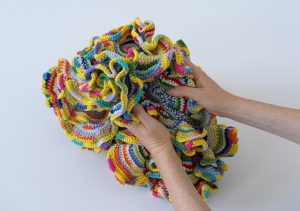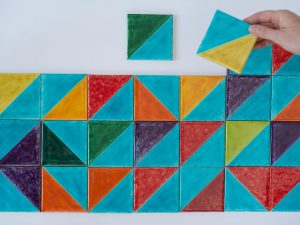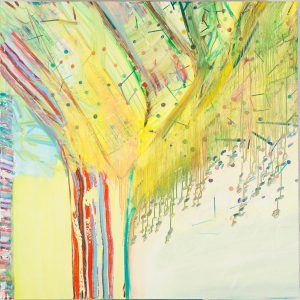
“My perspectives tend to deal with logical extremes”
Lotte Laub met with Visiting Art/ist Helena Kauppila at her Berlin studio, where they discussed her work and connections to mathematics and the natural sciences. The exhibition will open at the Finnish Institute on 18.2.2021 − digitally, for the time being.
LOTTE LAUB: You received a PhD in Mathematics from Columbia University and then you studied at the Art Students League of New York. How did you get from mathematics to painting?
HELENA KAUPPILA: Mathematics is actually what got me thinking about art. One day I came up with an idea: I would learn how to paint, I would place paintings next to the mathematics, and then people would obviously understand that they should ask me about the process instead of the conclusions. In the end, it was the physicality of painting that drew me to art.

LL: To what extent does mathematics inspire your artistic work?
HK: Because of my background, as an artist I am still deeply rooted in the scientific community. So, my art specifically incorporates systems uncovered by mathematics and science. I want to show that creativity and facts are not in opposition, but rather exist in a vital partnership.
LL: You give abstract contexts a human dimension through the gesture of painting. The fact that you work with oil on canvas is reminiscent of realistic landscape painting, as if you were going back to the 19th century and out into nature. But this nature has now been expanded into space, and with the help of the latest scientific instruments you can virtually transport yourself to a distant planet. Is this about seeing things from different perspectives?
HK: The real world is, for all practical purposes, infinite dimensional, because smells, sounds, even previous experiences, affect what we see in the present. In order to understand our relationship to a subject, it helps to switch between a variety of frameworks. For example, we may look at the night sky and see a universe full of planets and on each planet its own view of the stars, as if there was a telescope on them, or the softness of tree leaves might best be rendered if one organises the information in a fractal. All of these perspectives highlight a different aspect of reality.

LL: You pursue research interests in the natural sciences, at the same time here we encounter a classic painter’s studio. You work with oil on canvas, you also draw and even crochet. How would you describe the relationship between the subject and your chosen method of presentation?
HK: Most of the ideas I paint are physical; the inspiration is represented as a physical sensation. The structure of oil paint, and especially the layers are really important for me. In the work process, I make many explorations to develop my understanding of colour layering and arrangement. I also observe how people react to my work in a space.
Now I use different media to evoke different types of interactions. The crochet sculptures are made mostly with Merino wool. I want these pieces to be touched! Drawing and watercolour are portable and fast, you can put down ideas that are fleeting.
LL: During your artist residency in Istanbul you worked with ceramics. In this time you produced the work LUCA (2020). LUCA stands for Last Universal Common Ancestor, the organism from which all living creatures on earth today have descended. We are now dealing with the microscopic world of genetics, which you give shape to in an artwork made of tiles. You explored the traditions of tile making that are used to produce Iznik tiles. What connection do you see between the fundamental genetic conditions that all living things have in common and the way you chose to realise this work? To what extent is the abstract idea visible here? What role does the choice of colours play?
HK: It was really quite a privilege to be able to visit Iznik and to make the tiles there. I was very inspired by the location, and also by the modern designs produced at the Iznik Foundation. But always really great colours! The connection with genetics is something that arose during the residency. The mathematics behind aperiodic tilings suggests a puzzle-piece approach
Shifting the order, swapping pieces, these of course have analogies in genetics. For LUCA I encoded one particular gene, each square, based on its colour and the orientation of the triangle, stands for one codon in the genetic sequence. Tiles are especially interesting because they can be installed in public space.

LL: In your solo exhibition Inside Infinity at the Finnish Institute you will deal with the topics of nature, physicality and the senses. You have created paintings such as Tree of Life II that are inspired by your immediate surroundings. Coloured dots are drawn in the crown of the tree, and they form the ends of the rivulets of paint and give the impression of fruit on the branches. Or are they molecular structures? Or cells?
HK: They are atoms in molecules of schreibersite, especially the phosphorus atoms are important, these are needed in DNA. Schreibersite is found in meteorites. Without these meteorites, there might not be life on Earth.

LL: On the one hand you refer to your present environment, which you register with your senses: the tree in front of your window. When you talk about the ‘tree of life’, however, you are referring to more than the specific tree that you see every day. Are you also interested in the cultural-historical significance of the tree of life or is it more about a somatic-phenomenological relationship between the viewer and the painting?
HK: Yes and no. My perspectives tend to deal with logical extremes. I am interested in how an individual fits into or observes the whole. The tree, my window, winter turning into spring; these are filled with personal sensory impressions. So that’s the individual part. The whole, in this case the whole is life on Earth.
I tend to connect my work most with the culture of science.
Lotte Laub, curator and author
Translations: Tamerlane Camden-Dunne (interview), Ramona Tyler (additional texts)
This interview is a shortened version of the article The Tree of Life: Lotte Laub in conversation with Helena Kauppila in the exhibition catalogue In der Unendlichkeit – HELENA KAUPPILA – Inside Infinity. You can download the catalogue (8 MB) from here. The print version is available for 10 EUR plus postage at the Finnish Institute: Tel. +49-30-40 363 18 90, info@finstitut.de.
Editorial work: Katharina Bieling
—————–

